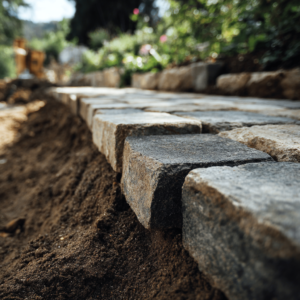Large pavers are well known for being very resistant and heavy, which makes them more difficult to move and therefore more difficult to install than small pavers. When using larger pieces one mau ask “how to lay large pavers?”.
Even with larger paving slabs, a paver installation isn’t a quick or easy process, but the results are well worth money and time.
In this article, you’re going to read and know more about how to lay large pavers, the installation process, and some tips and recommendations to make the process easier!
Jump to:
How to lay large pavers?
The process of laying large pavers is the same as small pavers, but a good thing is: the time you spend moving the large stones will pay off when you see the finished project coming together a little faster than it would with small paving slabs.
- Step 1: Prepare the ground by excavating approximately 4 to 6 inches (for foot traffic area) or 12 inches (for driveways or any type of surface that needs to hold a lot of weight) into the soil and making sure the ground below is well compacted and won’t shift in the future.
- Step 2: Lay 3 to 4 inches of gravel on top of the compacted soil. In this step, you can adjust the height of the finished project and to ensure you don’t have any dips or bumps. If necessary, slightly increase or decrease the thickness of the gravel base.
- Step 3: On the top of the gravel base, lay 2 inches of clean sand. The sand is the material that holds your pavers in place. Level the sand carefully with a straight board and compact it with a hand tamper.
- Step 4: Lay the pavers on top of the sand. Depending on your installation area and sin you are dealing with large pavers, cut some to fit might be necessary.
- Step 5: Leave approximately ½ inch of space between each paver. If you are using irregularly shaped pavers, you can fill larger gaps with small stones that won’t shift.
- Step 6: Once the pavers are all placed, use a plate compactor to tamp the pavers into the sand.
- Step 7: Dump stone dust on top of the pavers once they are in place and use a wide broom to sweep the dust into the gaps. It’s important to sweep at an angle to the cracks so you don’t gouge out the dust or sand below.
Tips to install large pavers
- Sand is a good “bed” for large and heavy pavers, but if you prefer, you can also set the pavers in mortar.
- Make sure each paver is on the same level as the one next to it, because even a small height difference is enough for someone to trip while walking on your pavers. If you are still worried about leveling, choose concrete pavers, they are more regular than natural stone pavers and need less adjustment to place.
- Geotextile fabric is highly recommended in areas of heavy traffic such as driveways to prevent soil movement beneath the pavers.
- If the area of installation has clay soil, you can cover the bottom and sides of the excavation with a geotextile fabric stabilizing layer before you add your base.
Benefits of installing large pavers
Both large and small pavers have their advantages during the installation process, but when you choose larger slabs, they cover more surface area at once, so can be installed relatively quickly.
The style is also another advantage, have you noticed when the pavers are larger, space seems bigger? That’s because large pavers have a more open, expansive style. If you are looking for a contemporary and modern design, laying large pavers might be the best option.
Can I lay large pavers by myself?
We recommend you not to. Larger pavers are heavy and difficult to move by yourself. When you do the work alone, there are higher chances that something can go wrong during the process and you also might need to be extra careful so no accident happens.
When you hire a professional, you have a guarantee of higher quality, beauty, and resistance of your pavers. Eventually, it becomes more advantageous, including financially speaking, to hire a pro to design and execute the project.
JS Brick Pavers offers more than 20 years of experience, dedication, and professionalism, from planning to the execution and maintenance of your project. Contact us!



